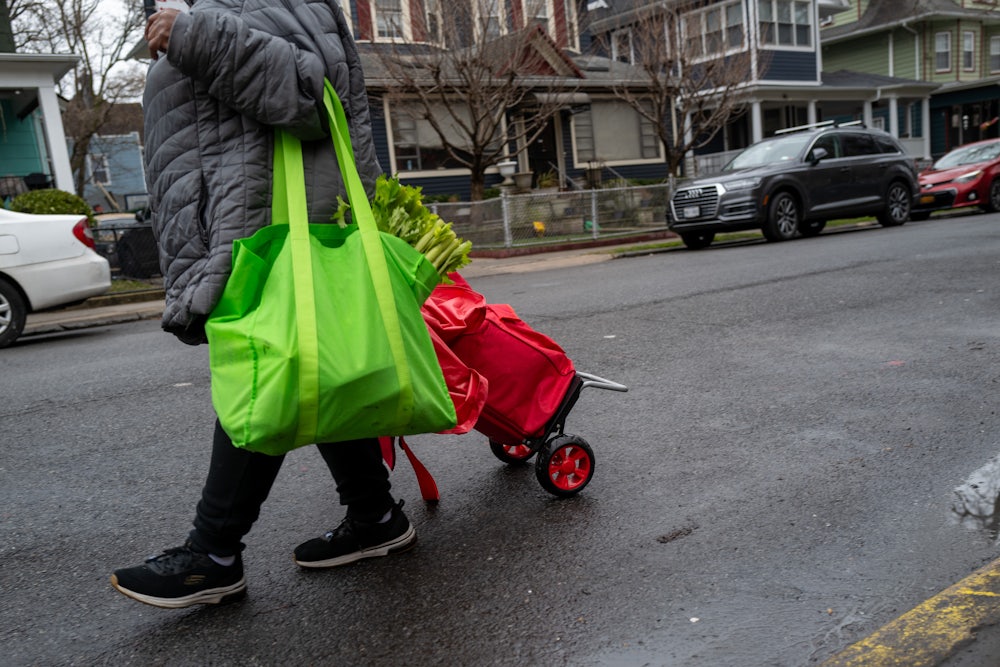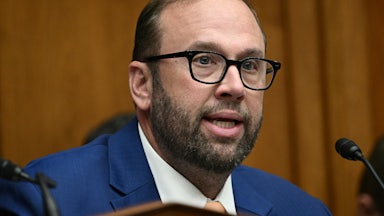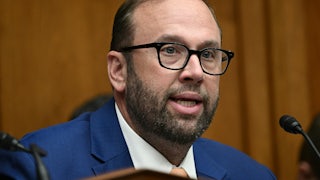Mahagani Jenkins appreciated the extra money—it just wasn’t enough. For an on-and-off six months, she was a participant in the Temporary Assistance for Needy Families program, known as TANF, receiving between $200 and $300 in monthly cash assistance. Jenkins, who received the benefits for four months while pregnant, used the funds to prepare for the birth of her son, purchasing necessities like diapers, baby clothes, and bottles.
When she qualified for TANF in 2022, Jenkins thought she might receive a larger amount. “It didn’t really help me be able to pay my bills, or anything else like that,” she told me.
This confusion was partially due to a lack of communication from the local office that was responsible for administering TANF. Jenkins, who is based in Denver, wasn’t aware of the program requirements—or the fact that there was an income cap to receive the assistance. It was determined that she earned too much income to qualify for more assistance, and so she dropped off the benefits cliff that so many low-income families are forced to confront.
“I ended up making too much money. I didn’t know what the limit was. I didn’t even know there was a limit until, obviously, I went over the limit, and it just got cut off,” Jenkins said.
Obtaining TANF benefits requires the recipient to be either working or actively searching for employment, but getting a job can push someone over the income threshold and off assistance. The purpose of TANF is, in part, to decrease reliance on government aid, but the very low income cap for obtaining the benefits across states means that one can still be very poor and not qualify for the program. In Colorado, the maximum amount a single person can earn and still obtain TANF benefits is just over $250 a month.
After her son, Ezra, was born, Jenkins was able to qualify for TANF again, but she lost the benefits shortly thereafter—this time, a failure to comply with stringent child support requirements tripped her up. While helpful on a small scale, TANF simply did not benefit her as much as the Supplemental Nutrition Assistance Program—also known as food stamps—and the Supplemental Nutrition Assistance Program for Women, Infants and Children, commonly called WIC.
But Jenkins’s experience reflects that of many would-be TANF recipients: In 2020, only 20 percent of eligible families participated in the program. “If the amount was larger, it would have played a bigger role, because at the time I wasn’t working when I had first found out I was pregnant,” she said. “So that was why I ended up on TANF. But then, once I found out how much I was getting monthly—$200 for a month. You can’t live on that as an adult.”
What Jenkins did not know at the time is that the amount granted to each state to spend on TANF was first decided in the mid-1990s and has not been increased since.
“Well, that would make sense, because back then, that might have been great,” Jenkins reflected. “But we’re in 2024, and a lot of things have changed.”
TANF was designed to provide low-income households with benefits—often in the form of cash assistance—while encouraging recipients to end their “dependence” on aid programs. However, it forces participants to jump through numerous bureaucratic hoops to obtain aid that is often insufficient to meet their needs.
“It’s a really important source of income as a last resort if you have nothing else. You can get SNAP to buy food, you can get Medicaid to cover your health expenses. But if you need to buy shampoo, or diapers, or anything like that, then you need TANF,” said Heather Hahn, the associate vice president for management in the Center on Labor, Human Services, and Population at the Urban Institute. Although research generally confirms the effectiveness of cash assistance in reducing poverty, TANF is far from a cure-all: The average of $500 per month for a family of three “is not going to lift anybody out of poverty,” said Hahn, an expert on TANF.
TANF was born of the “welfare reform” movement in the 1990s, a cross-partisan endeavor embraced by the likes of Democratic President Bill Clinton and Republican House Speaker Newt Gingrich. It replaced the Aid to Families with Dependent Children program, which grew from the expansive social service policies established in the New Deal. The AFDC was a federal entitlement program that reimbursed states for a portion spent on cash assistance.
The program became increasingly controversial in the 1980s and 1990s, as it was thought to disincentivize work and marriage, and it enforced no time limit on receiving aid. This maladroit perception of the AFDC was also racialized, thanks in part to President Ronald Reagan’s infamous denouncement of the so-called “welfare queen”: a Black woman allegedly using government assistance for ill purposes. This perception of the AFDC was pervasive across parties; in his 1992 campaign for president, Clinton pledged to “end welfare as we know it.”
The end goals of “welfare reform” are apparent in the title of the 1996 Personal Responsibility and Work Opportunity Reconciliation Act, massive bipartisan legislation that ended the AFDC cash assistance program, replacing it with TANF block grants. “Personal responsibility” and “work opportunity” were the explicit priorities, rather than an emphasis on poverty reduction.
“Those are big values that a lot of people can get around, can support, and gave it the political support that was necessary for passing the law,” said Hahn. “Those values, though, do not necessarily reflect the reality and the experiences of people who are seeking assistance.”
Under the current program, states are given a fixed amount of money for TANF and are required to contribute a portion of funding as well, known as “maintenance of effort.” States can then use those funds for the four purposes of TANF laid out in the 1996 law: to provide assistance so children can be cared for in their own homes or the homes of relatives, to reduce the dependency of parents on government benefits, to decrease out-of-wedlock pregnancies, and to support and promote the formation of two-parent households.
The amount of funding given to states was determined by what they had received prior to TANF’s enactment. The basic annual block grant of $16.5 billion to states and tribes has not been increased or adjusted for inflation since the program was first implemented—meaning that the value of that block grant in fiscal year 2023 was worth nearly 50 percent less than it was worth in fiscal year 1997. That might help explain why there has been a significant decrease in participation since TANF was implemented: In 1994, 79 percent of people eligible for cash assistance received it, compared to just 26 percent in 2018.
TANF administrators must find the right balance between offering cash assistance and funding other programs, such as spending portions of the grant on childcare, said Matt Lyons, the senior director of policy and practice at the American Public Human Services Association, which provides support to state and local human services agencies, including TANF administrators.
“If you are trying to work with TANF customers, and they don’t have access to childcare because there’s a 50,000-person waitlist for childcare subsidy slots, then maybe there’s a need to prioritize some of those TANF dollars going to those supports,” said Lyons.
States spend a relatively low amount of the block grant on cash assistance—states used only 23 percent of their TANF funds in fiscal year 2022 for this purpose. They also have broad authority to determine eligibility for the assistance program, as well as the amount of cash assistance doled out to those who make the cut. For example, according to the Urban Institute, a single parent with two children in Arkansas could only earn up to $278 per month to be eligible for TANF in 2022—the lowest amount in the country. The maximum monthly benefit a single parent with two children and no income could receive was $204. On the other end of the spectrum, a family of three in Minnesota in 2022 could earn nearly $2,700 and still obtain cash assistance through TANF. A family of three without income in New Hampshire could receive more than $1,100 per month.
Cash assistance may only be distributed to families with children under 18, and the federal program has a lifetime limit on providing that aid for more than 60 months, or five years. However, some states have set lower lifetime limits, while others dedicate funding from their own coffers to extend the limit beyond five years.
In the interest of fulfilling the stated purpose of encouraging two-parent households, recipients of cash assistance must participate in a child support program. Otherwise, they will risk seeing a reduction in their assistance or lose it altogether, depending on the state. But the child support payments may be claimed by the state and treated as government revenue, rather than going directly to the custodial parent. Colorado was the first state to enact a 100 percent “pass-through” policy, allowing the full amount of the child support collected on their behalf to be passed through to the family.
Hahn noted that many states have an incentive to keep the funds, to pay back themselves and the federal government for the cost of providing cash benefits. Twenty-two states currently do not allow any amount of child support to be passed through, while other states do not disregard the amount of the child support, counting it as family income and causing people to see their TANF benefits either decreased or cut off completely.
This provision can be difficult to fulfill for a single mom who does not know where the father of her child is, or how to contact him. It also adds an extra hoop to jump through for mothers like Jenkins, who felt as if she was already receiving sufficient help from her son’s father without needing to cooperate with the state’s child support establishment. (Another, separate hurdle exists for teenage parents: Federal law prohibits teenagers with their own children from receiving the benefits if they do not live in an adult-supervised setting.)
States must also reach a certain “work participation rate,” under threat of penalty. To meet that threshold, 50 percent of TANF families must be engaged in work activities for at least 30 hours a week, and 90 percent of two-parent households must participate in work activities.
Nevertheless, states can determine what it means to participate in work and decide whether a participant has “good cause” not to fulfill work requirements. In fiscal year 2022, states had an average participation rate for families of around 36 percent, with the rate for two-parent households hovering at 44 percent.
Despite its stringent requirements, TANF offers some flexibility that differentiates it from other welfare programs. “TANF is one of those few federal programs that, when you do it right, you really can cater to the individual in designing a system that’s wrapped around their needs,” said Lyons. “Cash is a central part of that solution. It’s also not the only solution to meeting that need.”
As states have large discretion over how TANF funds are administered, state-by-state programs can also expose the different theories of how to successfully reduce poverty and ensure family stability. For example, the Wyoming Department of Family Services recently adopted an overarching framework for its social services—including TANF—called “WY Home Matters,” predicated on the idea that families deserve to live in safety in their own home.
“It’s looking at it from a lens of wanting to provide for families on the front end to ensure that kids stay safe at home, because there is data that shows that kids do better when they stay at home. So what can we provide families in regards to concrete support, resources, case management?” said Corrine Livers, the economic security programs administrator at Wyoming’s Department of Family Services. That might entail approaching an interview to register for benefits more holistically: asking people if they have considered applying for other programs for low-income families, for example, or connecting them with mental health services.
While the amount dedicated to TANF by the federal government remains static, states can take action to reform the program. Starting in 2022, Louisiana doubled its cash benefit. Also in 2022, the Oregon state legislature approved a bill that made several changes to TANF, including raising the resource limit—the amount a household can have in assets and still qualify for the program—and using reserve program funds to provide a triannual clothing allowance.
“We’re really focused on the ways in which we can increase cash assistance, whether through direct cash assistance or preserving existing cash,” said Jen Corbridge, senior policy adviser at the Oregon Department of Human Services.
Other states that offer low cash benefits may prioritize other elements of TANF. For example, although Alabama dedicates a relatively low amount of the grant to cash assistance, the state spends significant TANF funds on early childcare and education, child welfare services, and short-term, nonrecurrent benefits.
These kinds of emergency benefits are not subject to TANF requirements for cash assistance, such as the 60-month time limit, child support assignment, and work requirements. However, they are only available to families with children, and intended to address immediate crises—such as impending homelessness—rather than recurring needs. As part of the ongoing response to the coronavirus pandemic in 2021, the federal government provided additional funds to states to spend on nonrecurring, short-term benefits.
“We have a very conservative legislature that is not going to increase TANF benefits on their own. And so our state agency has been put into a position of how to magnify these benefits with what money they have,” said Carol Gundlach, a senior policy analyst at Alabama Arise, an advocacy organization focused on poverty in Alabama. “They have kept the official benefit level low, and then they have provided a lot of other bonuses that have pushed up the kind of benefits that families get.”
This is “not a bad decision,” Gundlach continued, “but a federal standard would have made this an awful lot better.”
TANF is not a popular program to legislate in Congress, which may explain why the amount hasn’t increased in nearly 30 years or been indexed to inflation. The program was most recently reauthorized through the end of September, as part of Congress’s belated efforts to fund the government for the current fiscal year. The last significant change to TANF occurred in the 2023 Fiscal Responsibility Act, the deal reached between former Speaker Kevin McCarthy and President Joe Biden to raise the debt limit.
But other than the Fiscal Responsibility Act, TANF is under-discussed and little considered in Congress. Congressional Democrats have been focused of late on another policy intended to alleviate poverty for families with children: reinstating some version of an expanded child tax credit implemented during the pandemic, which offered additional cash benefits to low-income families.
Democrats also worry that any conversation about spending more money to increase the TANF block grant—or at the very least, index it to inflation—would be counteracted by Republican calls for increasing work requirements. It’s politically easier to reauthorize the program under the same levels than it is to discuss changes to a decades-old entitlement program.
Indeed, most current proposals to substantively overhaul TANF come from GOP lawmakers, who are generally most interested in increasing work participation and preventing misuse of program funds. In early March, Republican members of the House Ways and Means Committee introduced a package of bills to “ensure critical welfare dollars best serve low-income Americans, encourage a drive toward gainful employment, and protect hard-earned tax dollars from waste, fraud, and abuse.”
One of those measures was introduced by Representative Blake Moore, requiring states to spend at least 25 percent of their block grant funds on “work supports, education and training, apprenticeships, non-recurring short term benefits, work activities … and case management”—mirroring the TANF spending breakdown in his home state of Utah. While he described himself as a “states’ rights guy” in an interview, Moore said that he had “no qualms” about encouraging states to use federal funds with stricter requirements.
“Republicans aren’t trying to take away a safety net for people. We just want to make sure we’re doing it responsibly. I believe Democrats believe that same thing,” Moore said. “But it’s just like, you try to even make changes and reform things, and it just becomes hyperpolitical.”
Another idea to overhaul how TANF is administered comes from inside the White House. A new proposed rule would, among other provisions, limit TANF services to families living at 200 percent of federal poverty guidelines and create a standard to determine when an expenditure is “reasonably calculated to accomplish a TANF purpose.”
Remember when Hall of Fame quarterback Brett Favre was embroiled in a scandal in Mississippi that involved the misspending of TANF funds? This rule would attempt to crack down on practices like the one that allowed Favre to be paid more than $1 million in TANF funds for speeches he never gave. It also would attempt to end practices like Utah avoiding spending its own money on TANF by taking credit for $75 million in spending by the Church of Jesus Christ of Latter-day Saints. However, the rule has not been finalized, and it’s possible that some provisions could be challenged in court.
Some of the ideas in this proposed rule echo the measures brought forward by Republicans, indicating some possibility for bipartisan agreement on a policy level; but Washington is dictated largely by politics, not policy. Republican leadership on the Ways and Means Committee have accused the White House of attempting an end run around Congress with this rule proposal.
There are some reforms that TANF administrators would like to see implemented on a federal level, such as increasing the amount of the block grant, indexing it to inflation, and rethinking how employment participation is measured. The Fiscal Responsibility Act made modest adjustments to work requirements, but it also included a data-reporting requirement for states after a family leaves TANF, and created a five-state pilot program to explore new activities for increasing employment.
That pilot program, which would allow states to create new benchmarks for employment outcomes other than work participation rates, has garnered some interest from TANF administrators. “The question in my mind that I ask myself is, is workforce participation the appropriate model when we’re talking about this specific population? Is it actually appropriate to have work requirements for families that had so many barriers to traditional work?” said Oregon’s Corbridge about considering potential new metrics for success.
That sentiment was echoed by Livers of Wyoming, who said current participation rate requirements don’t take into account whether work is “meaningful.”
“It feels like we’re putting families into an activity to meet a rate, not necessarily to help the family,” she said. “There has to be some other way that we measure the effectiveness of this program, outside of just, are they participating 30 hours a week.”
Compared to other major anti-poverty programs, TANF serves relatively few people. In fiscal year 2023, nearly two million people received TANF benefits, including 1.5 million children. To put this in perspective, SNAP serves around 41 million people, and WIC has roughly six million participants—including nearly 40 percent of all infants in the country. When the pandemic-era expanded child tax credit was implemented between July and December 2021, it reached nearly 62 million children and lifted 3.7 million children out of poverty. That version of the child tax credit boosted the size of the benefit, disbursed it in monthly payments, and made it fully available to the lowest-income families in the country.
“What we saw in 2021 provides pretty indisputable evidence that a federally administered child benefit that provides unconditional cash support to nearly all families with children by far is superior to what we get from the TANF program,” said Zachary Parolin, an assistant professor of social policy at Bocconi University in Milan, and a senior research fellow at Columbia University’s Center on Poverty and Social Policy. TANF cut child poverty by around 2.9 percent in 2020, while the expanded child tax credit slashed the child poverty rate by roughly 44 percent the following year.
In February, the House passed a bipartisan tax bill including an expansion of the child tax credit that, while less generous than what was seen in 2021, would by one estimate lift 400,000 children above the poverty line and make another three million children less poor.
“It’s fair to say that, especially with this expansion, the child tax credit’s overall poverty reduction effect … would still be substantially larger than what TANF is achieving right now,” said Parolin. “There’s just not enough cash support being provided for TANF families, and there’s not enough families receiving it. Even if in some places the benefits could be generous, the overall poverty reduction effect is small.”
Parolin’s research has also shown that racial disparities in how TANF funds are administered across states have contributed to higher rates of poverty among Black children; moreover, states with a high percentage of Black residents are less likely to use their TANF funds to offer significant cash assistance. Here, we can turn again to Alabama, which has the second-lowest maximum cash benefit in the country, and where more than a quarter of the state’s population is Black.
Given the flaws baked into TANF’s design, some researchers believe it would be better for the program to be scrapped altogether and replaced with a generous child benefit akin to the expanded child tax credit. However, even the tax bill implementing modest changes to the child tax credit is stalled in the Senate, indicating the unfeasibility of such a scenario. (In his initial proposal to create a child allowance, GOP Senator Mitt Romney suggested eliminating TANF; his later iteration of the bill excised that provision.)
“In an ideal world, if you could immediately stop TANF and institute a different system instantaneously, that would be great. It has so many challenges with it,” Hahn, of the Urban Institute, said. “As a practical matter, there is a concern that people could be left with nothing in the meantime.”
For those who work with TANF every day, eliminating it would not only be impractical, it would take away the only form of cash assistance that many very poor families have. TANF has almost innumerable flaws—but beyond consideration as a theoretical matter, abandoning the program might be more damaging than keeping it in place as is.
“TANF isn’t effective because we’ve made it so through very, very intentional policy decisions,” said Corbridge.
But even if those policy decisions are unlikely to be changed on the federal level, eliminating it would still leave those very poor families who rely on it without recourse. “I think that attacking poverty using every tool that we have, is really, really important,” Corbridge continued.










